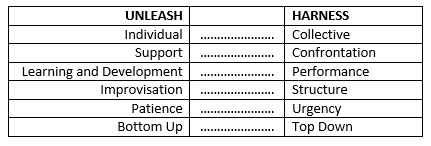"'When it comes to innovation, leadership matters, and it’s not leadership as commonly conceived today.' Every person in your group, whether that’s a small team or a large corporation, contains a slice of genius. Your task as leader is to create a place where all those slices can be elicited, combined, and converted into collective genius."
- Collective Genius, page 7
"The unavoidable paradox at the heart of innovation is the need to unleash the talents of individuals and, in the end, to harness those talents in the form of a collective innovation that is useful to the organization."- Collective Genius, page 26
Paradox: a statement or proposition that seems self-contradictory or absurd but in reality expresses a possible truth.
This is why leadership of innovation is so difficult. It requires thriving in the paradox of unleashing and harnessing. Absurd, but true.
You need a place that unleashes ideas and options, a creative free-for-all where anything goes and everything is possible. But, you also need a place that produces a final solution—just one answer that solves a specific problem.
This is the fundamental paradox at the core of leading innovation. Ultimately, innovation is the result of effective collaboration of diverse people. But collaboration requires give and take, discussion, and even heated contention. Based on their study, the authors identified six paradoxes related to the core unleash/harness paradox.

The implications of these paradoxes explain why innovation is inherently difficult. Managing and balancing each of these paradoxes in context and at the right time is the tough work of the leader and everyone involved. It’s not easy. But in their extensive research of innovative companies, the authors found these common themes consistently exhibited.
I’ll admit, I’m more of an ‘unleash’ type of person, but I realize that the ‘harness’ is necessary to actually get things done. So my task is to do more harnessing in my life, but also realize its importance in my organization.
"The wise leader knows that innovation is voluntary."- Collective Genius, page 70
You can’t compel someone to care. But unless they do, you won’t have an innovative environment.
How do you create caring creative employees? People need to be heard.
When people feel heard, it’s like a breath of fresh air. And once they feel that freedom, they’re ready to offer their best ideas to solve whatever problems emerge. People united by a common purpose and willing to help each other is called a community. Rather than a place where “that’s not my job”, creating a community is one of the best strategies for developing a ‘willingness to innovate.’ It seems simple in concept, but is difficult to execute. It takes pulling down the silos and organizational structure that creates false barriers between people, and creating a unifying purpose that is greater than any individual’s goals.
“Purpose – not the leader, authority, or power – is what creates and animates a community.” In order to work through the hard tasks of innovation, such as conflict and tension, or navigate through the other paradoxes, the community needs a strong purpose – the reason it exists, the ‘why’.
I plan to articulate and frequently communicate a more meaningful purpose to those around me that I work with on various projects. I will also create a better sense of community by being helpful to others even when it’s not part of my job.
"A decade of observing innovative organizations has convinced us that the best leaders of innovation don’t see themselves as people with all the answers who set a direction for others to follow."- Collective Genius, page 117
Innovation requires certain organizational skills that can be encouraged by the leader. There are three capabilities that correspond to three key aspects of the innovation process: collaboration, discovery-based learning, and integrative decision making.
I’ll be working on creating these abilities for myself. And letting them infiltrate more significant projects that I have at work.
How do you plan to build the creative genius in your organization?
Emily Truelove is a researcher with a decade of experience studying leadership, innovation and organizational change in firms around the world. She is currently a PhD candidate in Organization Studies at MIT Sloan School of Management.
